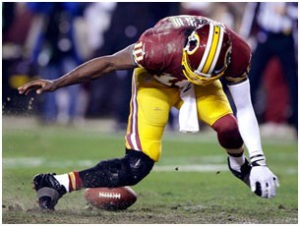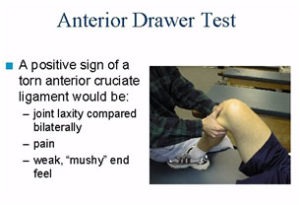What is Anterior Cruciate Ligament Injury or ACL Tear?
Anterior Cruciate Ligament (ACL) is present inside the knee joint within the capsule and it prevents excessive anterior translation of tibia over the femur.
Anterior Cruciate ligament injury or ACL tear is a relatively common problem of the knee in athletes and is the most debilitating Knee Ligament Injury compared to other ligament injuries.
Sports that require frequent tackles, pivots, and sudden change in directions like football, rugby, basketball, tennis, volleyball, hockey, dance, and gymnastics have high incidences of ACL injury.
What are the causes of Anterior Cruciate Ligament Injury?
An ACL injury is a sports-related knee injury. Most often ACL tears occur when pivoting or landing from a jump. The knee starts to give way from under surface following an ACL tear.

(pic- ACL injury while pivoting)
Female athletes are more prone to an ACL tear. Theories for females being more prone suggests recruitment pattern paradoxy of quadriceps and hamstring muscles, hormonal and biomechanical difference to a male counterpart.
What are the Symptoms of ACL Tear?
Common complaints of the patient suffering from ACL Tear are :
- Pain around Anteromedial region of the knee;
- Swelling and Ecchymosis;
- The joint giving way from under surface.
Diagnosis for ACL!
Clinical examination will reveal signs of ACL ligament instability. The common special ACL tests are Anterior Drawer Test and the Lashman test.

An MRI may be needed to find the extent of injury (grade) and if any associated injury within the knee which is common.
Anterior Cruciate Ligament Injury Treatment!
The symptoms of ACL tear may start settling within a few weeks, but as the patient starts to feel better there are chances that the knee joint may start giving way at this point of time.
All ACL tear doesn’t need reconstruction surgery. The factors that decide whether a patient with an ACL tear is a suitable case for ACL reconstruction-
- Age of the patient
- Grade of an ACL tear.
- Regular participation in a sporting activity that needs a functional ACL.
- The feeling of knee instability
- Future plans
NOTE: If a person with ACL tear doesn’t participate in a multi-directional sport that requires a functional ACL and doesn’t have a feeling of the unstable knee, he doesn’t need to undergo ACL reconstruction surgery.
Physiotherapy For Anterior Cruciate Ligament (ACL)
A patient can undertake a comprehensive ACL – Rehabilitation Program to avoid ACL reconstruction surgery. This involves leg strengthening, proprioception, and high-level balance training plus sport-specific agility and functional training.
The aims of physiotherapy treatment are :
- Reduce pain and inflammation.
- Normalize joint range of motion.
- Strengthening the knee muscles.
- Strengthening the lower limb muscles.
- Improve patellofemoral (kneecap) alignment.
- Normalize muscle lengths/ stretches.
- Improve proprioception and balance
- Improve functionality e.g. walking, running, squatting, hopping, and landing.
- Minimize re-injury.
We at Pain-Free Physiotherapy help diagnose your problem and efficiently treat it. Contact an expert at our clinic for the best advice.
ACL Surgery
A knee surgeon is the best person to discuss whether ACL reconstruction is advisable or not.
The surgery that is usually undertaken for an ACL tear is called ACL reconstruction. A repair of the anterior cruciate ligament is rare and thus the ACL is reconstructed using another tendon or ligament to substitute for the torn ligament.
Post-Surgical ACL Rehabilitation
Post-operative ACL rehabilitation is one of the most important, yet too often neglected, aspects of ACL reconstruction surgery. One must undergo physiotherapy rehabilitation post-surgery for a quicker and better outcome.
Post-surgery ACL rehab focuses on restoring full knee motion, strength, power and endurance, balance and proprioception, and agility training which should be individualized to one’s specific sporting or functional needs.
Return to Sports after an ACL Injury
The return to sports after ACL injury is quite difficult even after reconstruction surgery and at times athletes/individuals have to give up the sporting activity.
The best chance of returning to sports post-ACL tear is to undergo intensive post-operative Physiotherapy rehabilitation.
Prevention from ACL Tear.
A knee strengthening, agility, and proprioceptive training program is the best way to reduce the chance of a knee ligament sprain. Premature return to high-risk activities such as sport may increase the chance of reoccurrence.





